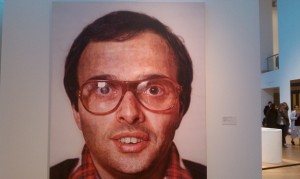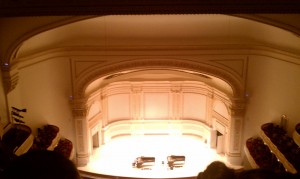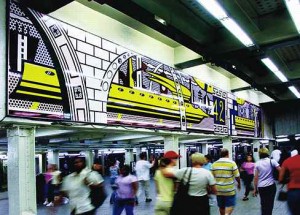In Big Bambu, by the Starn Twins, Boiseries, by Katrin Sigurdardottir, and County Cork, Ireland by Richard Long, I felt that the primary alteration of perspective was caused by how each art piece utilized space, and the ensuing feeling of dislocation. Big Bambu was situated atop the Metropolitan Museum of Art, with a great view of the New York City skyline and the treetops of a small park below. Walking through Big Bambu caused me to feel as though I were in a gigantic cage, although I didn’t feel trapped or enclosed. Instead, I experienced wonderment and awe looking up and around at the numerous webs and patterns that were created by the intersection of bamboo stalks. The feeling of dislocation was caused by the combination of Big Bambu’s material of choice, bamboo, and the aforementioned space at the top of the museum. Walking through a tangle of bamboo is an experience enough on its own, but doing that while simultaneously seeing a combination of trees, the sky and the New York City skyline created an acutely surreal experience for my sense of sight that I doubt I will experience again any time in the near future.
The Boiseries created a much more sinister alteration of perception and sense of dislocation than Big Bambu. While Big Bambu was outside and generally pleasing, the Boiseries gave me the feeling of being in some kind of altered-reality, Willy Wonka mental institution. There was one in particular that was closed off so that you could not be inside. The interior was pristinely white, unnervingly so from my point of view, and the perfect arrangement of white furniture, gave me an oddly specific image of a young girl in an all-white dress sitting at the powdering table and talking to a doll. The two-way mirrors also added to the overall impression of an asylum. If I had to stay in that room I could definitely imagine myself losing a bit of my sanity.
Richard Long’s photograph County Cork, Ireland created a much more benign sense of dislocation. I sensed warmth and friendliness from this photograph, which was definitely enhanced by its silvery antiquity. I think that the sense of dislocation was caused primarily by the different ways you can perceive it. I think that this photo can be perceived both as a close up shot of a small, but perfect circle in the field, or as a kind of diagonal bird’s eye view of a very large circle in a field. Imagining taking this photo either from extremely close up or very far away plays with my mind’s eye and forces me to displace or dislocate myself in space. All three art pieces did a very good job of encouraging and enabling this dislocation in the space-time continuum.
My favorite picture from the contemporary photography gallery:

And some pictures I took from inside and outside Big Bambu:





























